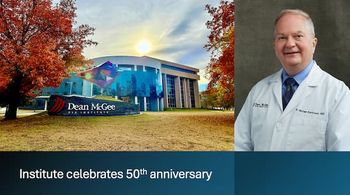
Trial tests juxtascleral agent for halting AMD progression
Baltimore—A prospective study is now under way, designed to investigate the efficacy and safety of anecortave acetate for depot suspension (Retaane, Alcon Laboratories) for arresting the progression of "dry" age-related macular degeneration (AMD) in patients at risk for developing exudative disease, said Andrew P. Schachat, MD, at the Current Concepts in Ophthalmology meeting.
Baltimore-A prospective study is now under way, designed to investigate the efficacy and safety of anecortave acetate for depot suspension (Retaane, Alcon Laboratories) for arresting the progression of "dry" age-related macular degeneration (AMD) in patients at risk for developing exudative disease, said Andrew P. Schachat, MD, at the Current Concepts in Ophthalmology meeting.
"Results from studies of anecortave acetate for the treatment of AMD-related neovascularization demonstrated it offered superb safety and provided a fairly reasonable hint that it was efficacious. Therefore, it seems reasonable to test this agent as a prophylactic intervention in eyes at risk for progression to wet AMD," said Dr. Schachat, professor of ophthalmology, Wilmer Eye Institute, Johns Hopkins University, Baltimore.
Anecortave acetate is a cortisol structural analog, but by virtue of its molecular modifications, it is devoid of glucocorticoid activity and the associated risks of IOP elevation and cataractogenesis. Moreover, because anecortave acetate is administered as a posterior juxtascleral injection-within the orbit but not into the eye-it avoids risks of endophthalmitis and iatrogenic cataract.
"That is not to say that the risks are zero, but the safety outcomes to date are very favorable, and efficacy analyses indicated the majority of eyes treated with anecortave acetate 15 mg maintained a positive visual outcome and avoided severe vision loss," Dr. Schachat said.
In the prophylaxis study, 2,500 patients are randomly assigned to treatment with anecortave acetate 15 mg, anecortave acetate 30 mg, or sham injection. Assigned treatment will be repeated every 6 months and planned follow-up duration is 5 years.
Eligible patients must be at least 50 years old with a clinical diagnosis of exudative AMD in the non-study eye. The study eye must have best-corrected ETDRS logMAR visual acuity ≥0.3 and a diagnosis of dry AMD with at least five or more intermediate (>63 μm) or larger soft drusen and/or confluent drusen and hyperpigmentation within 300 μm of the foveal center.
Those criteria were selected based on analyses determining risk factors for progression from dry to wet AMD in fellow eyes of patients with wet AMD in the contralateral eye who were participants in the Macular Photocoagulation Study and the Age-Related Eye Disease Study.
"Stay tuned for the results. We are hoping anecortave acetate will be effective because there is a 50% risk of progression to wet AMD within 5 years in fellow eyes with very large drusen and hyperpigmentation," Dr. Schachat said.
Newsletter
Don’t miss out—get Ophthalmology Times updates on the latest clinical advancements and expert interviews, straight to your inbox.


















































.png)


